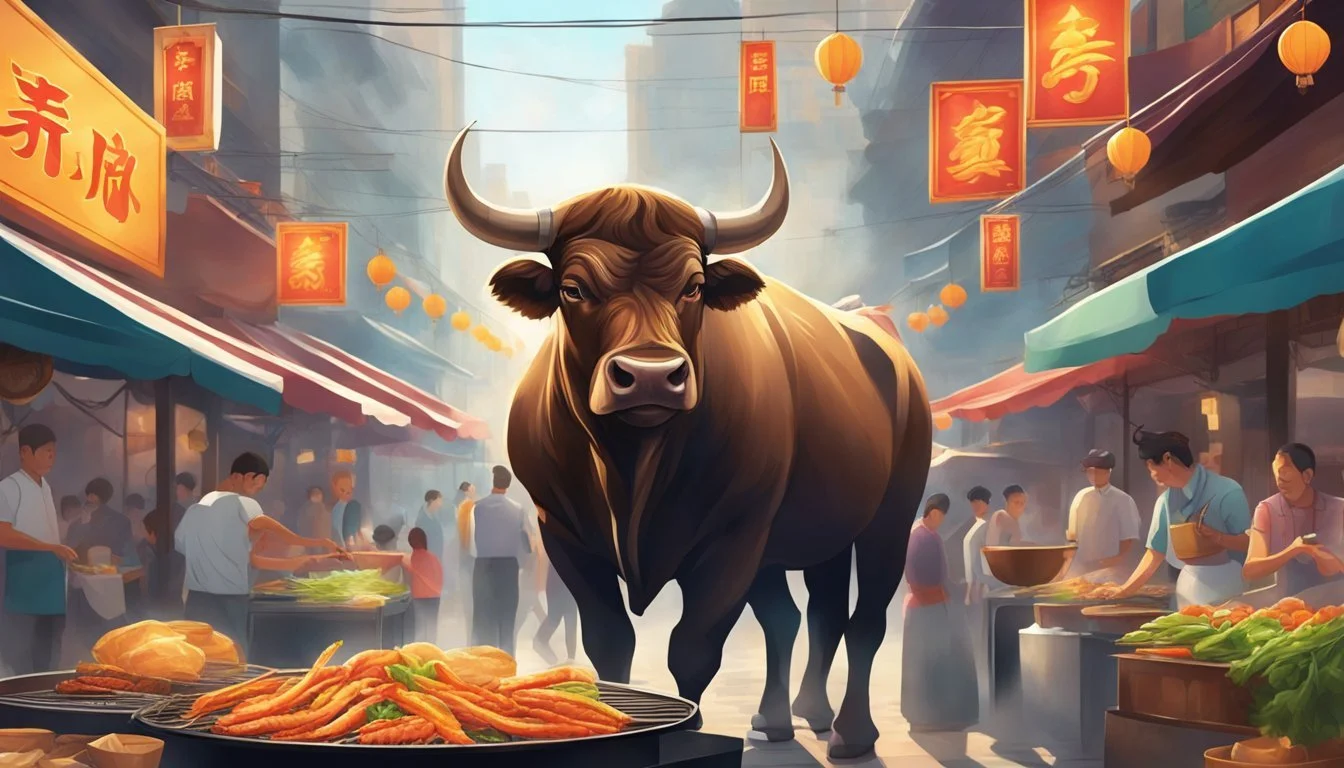Bull Penis Delicacy
Exploring the Unique Texture in Chinese Street Food
In the varied landscape of Chinese street food, one dish stands out for its unique texture and controversial appeal: the bull penis. Known in some places as beef pizzle, it's a food item that captures the curiosity of adventurous eaters and is sometimes found in specialized restaurants in China. With a history intertwined with traditional medicine, where it's valued for its supposed aphrodisiac properties, bull penis is a dish that invites both intrigue and apprehension among its audience.
The culinary scene in China is rich with dishes that challenge the palate, and street food is a dynamic platform where such culinary experiments thrive. Although it may not be as common as other street snacks, the preparation of bull penis involves careful cleaning and cooking to achieve the desired texture that's often described as the central experience of consuming the dish. Texture is a crucial aspect of Chinese cuisine, and this peculiar food item's chewy and somewhat rubbery consistency offers a distinct sensory experience.
For those with a curiosity about the different facets of Chinese cuisine, encountering bull penis as a street food option opens up a conversation about the broader food culture in China. It reflects the vast range of flavors and textures appreciated by Chinese gastronomy and the openness to include a variety of ingredients in the diet. While the initial reaction to bull penis may be one of surprise, the dish serves as a testament to the complex and diverse nature of food traditions in China, capturing an audience eager to explore beyond the conventional.
The Popularity of Bull Penis in Chinese Cuisine
Bull penis, known in the culinary world as "beef pizzle," is regarded as a delicacy in China. This unique dish is often encountered in specialty restaurants and street food stalls, reflecting a particular facet of Chinese culture that embraces a wide variety of textures and flavors.
In Chinese cuisine, texture plays a pivotal role and bull penis is no exception; its fame is partly built upon its distinctive, somewhat springy texture that provides an unusual mouthfeel. The preparation of bull penis often involves meticulous cleaning, soaking, and slow cooking methods to achieve the desired tenderness and to ensure safety for consumption.
Tourists and businessmen alike may find themselves intrigued by this uncommon dish, thus contributing to its popularity. Restaurants in Beijing and other major cities in China have integrated bull penis into their menus, serving it as a testament to the diverse culinary practices of the country.
Here's a snapshot of its place in Chinese gastronomy:
Cultural Significance: Regarded as an aphrodisiac in traditional Chinese medicine.
Texture: Springy and unique, often highlights the importance of texture.
Preparation and Cooking: Involves careful cleaning, soaking, and slow-cooking processes.
Popularity: Attracts tourists and local patrons for its novelty and taste.
Availability: Found in specialty and street food establishments across China.
These characteristics showcase bull penis as not just a food item, but also as a reflection of the adventurous side of Chinese gastronomy that values the unusual and the traditional in equal measure.
Culinary Preparation Methods
This section focuses on the various traditional and modern ways bull penis is prepared as a Chinese street food, elaborating on the use of spices, serving styles, and its presence beyond the streets of China.
Traditional Cooking Techniques
Bull penis, known as beef pizzle, requires lengthy cooking to achieve its characteristic texture. In traditional preparation methods, the penis is cleaned and simmered for hours to tenderize the meat. This approach allows the initially tough tissue to soften and become more palatable. It's not uncommon for the meat to be cooked slowly overnight to develop its flavor fully.
Popular Condiments and Spices
The unique taste of bull penis is often enhanced with bold spices and condiments. Common ingredients include:
Soy sauce for umami,
Chili for heat,
Garlic and pepper to add pungency and depth,
Cilantro for a fresh, herby note.
These condiments are either incorporated during the cooking process or provided on the side for dipping.
Serving Styles
In Chinese street food culture, bull penis may be sliced thinly and served in a hotpot, allowing diners to cook the meat to their desired texture. Alternatively, it can be presented in baozi (steamed buns) or inside a Chinese hamburger, known locally as jianbing, allowing the blend of texture and flavor to be appreciated in each bite.
Alternative Delicacies
Beyond bull penis, Chinese street food vendors offer a variety of unusual eats. Items like stinky tofu, balut (developing bird embryo), centsury egg, and scorpion are considered delicacies. Each item offers a distinct combination of flavor and texture unique to Chinese culinary traditions.
Uncommon Street Foods
The roster of Chinese street foods includes remarkably unique items such as tarantula, snake soup, and frog legs. These foods, like bull penis, are often valued for their textures, ranging from the crispiness of fried tarantula to the tenderness of steamed frog legs.
Adaptations Beyond Chinese Streets
Internationally, adaptations of this Chinese delicacy in private dining experiences or themed restaurants take on a more refined presentation. Some establishments serve it with gold cutlery in private rooms, elevating the dining experience. Additionally, a personal waitress might be available to guide diners through the menu and explain the various preparation styles.
Texture as a Central Experience
In the culinary landscape of Chinese street food, the consumption of bull penis, known as niu biao in Mandarin, highlights a distinct focus on texture. Cooks often consider texture to be as important as flavor. They prioritize the tactile experience, creating dishes that offer a variety of sensations.
Bull penis is renowned for its unique texture. When prepared properly, it manifests a chewy resilience that is highly valued in Chinese cuisine. The cooking method is designed to achieve a balance between tenderness and a firmness that 'pushes back' upon the first bite. This QQ texture—a term from certain Chinese dialects— typifies food that maintains a pleasant resistance before yielding.
Cooking Techniques:
Initial Preparation: The bull penis is blanched and then bathed in cold water.
Finishing Touch: It's often stir-fried or braised to enhance its texture.
The expected texture is neither too soft nor overly rubbery, tiptoeing on the edge of being slightly slimy yet pleasantly chewy. Consumers of this dish appreciate this texture, viewing it as an integral part of the tasting experience. The tactile sensation is a centerpiece of the dish's appeal and is indicative of the broader culinary culture, where the feel of food in the mouth is a meticulous aspect of dining.
Texture serves an experiential purpose, transforming a meal into a multidimensional journey. In this context, the elasticity of bull penis is not just a quirk but the crux of its culinary identity, exemplifying how texture can define the enjoyment and cultural significance of certain foods.
Nutritional and Health Considerations
Bull penis, known also as beef pizzle, is consumed in several parts of China. Traditionally, it is reputed to be an aphrodisiac and is believed to have various health benefits. The dish is rich in proteins and contains various vitamins and minerals, contributing to its healthful claims.
In terms of nutrition, beef pizzle is:
A source of protein, necessary for muscle repair and growth.
Low in fat, making it a leaner choice of meat.
Packed with vitamins and minerals, such as vitamin B12, zinc, iron, and magnesium.
Health enthusiasts may point to the collagen content in bull penis, which is suggested to help with skin health and connective tissues, while traditional medicine practitioners may claim its benefits in enhancing male vitality due to its symbolic association with virility.
Beef pizzle is also consumed for its texture. While it does not contribute directly to nutritional value, texture can affect the digestibility and satisfaction of food, thereby indirectly influencing dietary experience and choices.
As for testicles, often referred to as "Rocky Mountain oysters," these are another byproduct of the bull consumed for their flavor and believed health properties. They contain nutrients similar to other organ meats – a significant source of protein and also zinc, which is important for immune support and reproductive health.
It is crucial to note that no conclusive scientific evidence supports the aphrodisiac or other traditional health claims associated with eating bull penis or testicles. As with any specialty food, if individuals choose to include bull penis in their diet, it should be consumed in moderation within a balanced nutritional regimen.
Comparative Foods by Texture and Flavor
When exploring Chinese street foods like bull penis, the journey is as much about texture as it is about flavor. Distinctive mouthfeels paired with unique taste profiles define the culinary landscape.
Other Textured Delicacies
In the realm of texture, chicken feet are a notable Chinese snack. They possess a gelatinous consistency that offers a contrast to the chewiness of bull penis. Jellyfish, another specialty, is prized for its crisp and somewhat rubbery texture, frequently served in salads.
Tripe, on the other hand, introduces a tender yet resilient chew that complements spicier dishes. Its intricate ridges and patterns also add visual appeal to a meal. These foods challenge the Western palate but are cherished in Chinese cuisine for their distinctive textural components.
Flavor Profiles in Chinese Cuisine
The flavors accompanying these textures are equally diverse. For instance, the natural flavor of beef used in dishes like bull penis is often enhanced with bold spices. Spicy elements, such as Sichuan peppercorns, bring heat and a tingling sensation, creating an intricate flavor profile.
Sweeter touches, typically from sugar, balance spiciness, while onion adds a pungent, aromatic layer. This interplay of flavors is intentional, creating a complex culinary experience where each mouthful conveys a symphony of tastes that harmonize with the unique textures presented in the dish.
Cultural Significance and Local Practices
Bull penis, known as "beef pizzle" is a distinctive item within Chinese street food culture. Its preparation and consumption reflect a rich historical context, evolving modern trends, and draw culinary tourists, particularly to Sichuan Province.
Historical Context
The tradition of eating bull penis in China dates back centuries, rooted in the country's diverse culinary heritage. Medicinal use: In traditional Chinese medicine, beef pizzle is valued for its purported aphrodisiac properties and is associated with enhancing virility. Cultural practice: As a dish, it is more than a food item; it symbolizes strength and potency, echoing deep-seated cultural beliefs about the restorative powers of consuming animal organs.
Modern Consumption Trends
In recent times, bull penis has transitioned from traditional medicine to become a sought-after delicacy among younger audiences and businessmen. Demand dynamics: While still revered for its supposed health benefits, its texture and novelty factor now drive its popularity. Food fairs and street vendors: Integral to the vibrant street food scene, beef pizzle is often offered by vendors and at food festivals, catering to both locals and curious travelers.
Culinary Tourism in Sichuan Province
Sichuan Province, known for its bold flavors and spicy cuisine, has become a hotspot for culinary tourists seeking authentic and unconventional eating experiences. Key attractions: Here, beef pizzle is often prepared with the region's signature fiery spices, attracting both adventurous eaters and those interested in the gastronomic culture. Tourist feedback: Travelers are often drawn to the province not just for the food, but for the lively market atmosphere and the chance to engage directly with a facet of Chinese culture that challenges their culinary boundaries.
Consumer Insights and Market Dynamics
Understanding the consumer interests and the economic factors influencing the market is pivotal when assessing the potential of bull penis as street food in China, particularly with its appeal for its distinctive texture.
Demand Among Different Consumer Segments
The consumption of bull penis, known locally as 牛鞭 (niúbīan), varies across different consumer segments in China. Tourists and adventurous food enthusiasts often seek out such unique delicacies to experience traditional flavors and culinary practices. For businessmen and locals, this food could be a part of casual street dining or a late-night indulgence after social events. Restaurants selling exotic cuisine target customers looking for new textures and flavors, thereby capitalizing on the curiosity of consumers who frequent street food stalls for an authentic taste of local street foods. In particular, regions with a high concentration of eateries that sell steamed buns, like baozi, may see a parallel demand for other unique street delicacies, including bull penis.
Pricing and Affordability
Pricing plays a critical role in the market dynamics of street food offerings such as bull penis. The affordability can vary greatly:
Restaurants offering a more refined setting might charge premium prices.
Street food stalls, on the other hand, generally target more cost-effective pricing strategies to cater to daily wage workers and budget-conscious consumers.
This variation in prices allows for a wider range of consumers, from budget diners to those willing to experiment with higher-end exotic dishes. It is important for businesses to set their prices strategically to tap into the varying levels of spending power while ensuring profitability.
Fusion and Innovation in Street Food
The landscape of street food has seen a remarkable transformation driven by intense creativity and experimentation. Fusion cuisine has emerged as a captivating trend, with street vendors combining traditional flavors in novel ways. This not only caters to contemporary palates but also reflects the merging of cultures in our increasingly global society.
Bull penis, known as beef pizzle, is often incorporated into inventive dishes that draw on ingredients and techniques from various culinary traditions. The result is a range of offerings that challenge and expand upon the conventional understanding of street food. They exemplify innovation, with vendors devising new methods to serve and enjoy this ingredient, enhancing its unique texture and assimilating it into diverse food forms.
Western Influence: Introduces western ingredients and styles of serving, broadening appeal and adding variety.
Creativity: Pushes the boundary of traditional recipes, resulting in surprising yet delightful culinary twists.
These innovations often arise not only from a desire to explore but also from economic necessities. The need to stand out in a crowded market compels vendors to constantly innovate. This might involve adapting to Western influence by adding non-traditional spices or adopting methods like grilling or frying.
The intersection where traditional street food meets modern fusion is where the most dynamic culinary experiences are born. It's a testament to human creativity that such combinations not only exist but are also thriving, offering gastronomes new tastes and textures to savor.
Final Thoughts on Bull Penis as a Street Food Staple
Bull penis, often referred to as 'beef pizzle', is a Chinese street food item that has stirred curiosity and conversation worldwide. Street food in China is known for its vast variety and the way it reflects the rich culinary tradition. Chinese cuisine doesn’t shy away from using diverse parts of animals, and the inclusion of bull penis is a testament to this culinary adventurousness.
Texture is a critical attribute in Chinese street food, and bull penis brings a unique one to the table. It's neither for the faint of heart nor for the unadventurous eater, but those willing to try it often speak to its chewy and tender texture. Preparations typically involve braising or stewing to achieve the desired tenderness.
In Chinese culture, bull penis is not only a food item but also credited with medicinal properties, specifically as an aphrodisiac. This belief adds to its popularity and maintains its place as a staple in street food markets. People enjoy it for both its supposed health benefits and its status as a culinary oddity.
Here is a list of what consumers should anticipate when considering bull penis as a street food:
Variety: Available in multiple preparations, from soups to stir-fries.
Culture: A traditional item reflecting the non-wasteful nature of Chinese cuisine.
Medicinal Beliefs: Consumed within the context of traditional Chinese medicine.
Notability: Its inclusion highlights China's broad definition of edible meats.
While it might seem unconventional to outsiders, for many Chinese locals, it is just another ingredient in their rich culinary landscape. Visitors to China may encounter it among the myriad of street food options, offering a window into an aspect of food culture that challenges international palates and perceptions.
Frequently Compared Eateries and Foods
When venturing into the realm of unique Chinese street foods, one finds that bull penis is often just the tip of the iceberg. Street vendors and eateries that specialize in this food also frequently offer a variety of comparable traditional delicacies known for their distinctive textures and flavors.
Similar Chinese Street Foods
Chinese Sausage: A common sight in markets, offering a firm and snappy texture.
Chicken Feet: Prized for their gelatinous texture; a staple at many dim sum restaurants.
Tripe: Another texturally complex dish served spicy or simmered in soups.
International Comparisons
In international markets, comparable foods based on texture might include:
Jellyfish: Served in Asian restaurants across America and the UK, appreciated for its crispness.
Beef Pizzle: Seen in some ethnic enclaves in America, similar to bull penis but less common.
Related Street Foods by Texture
Exploring Chinese street foods, one encounters textures that engage and challenge the palate:
Donkey Meat: Often described as tender and part of northern Chinese cuisine.
Dog Meat: Still consumed in specific regions despite controversy, known for its chewiness.
Each of these foods reflects cultural attitudes towards texture and flavor that are hallmarks of Chinese culinary tradition.
Appendix: Extensive List of Chinese Street Foods and Delicacies
Chinese street food is a vibrant tapestry of flavors, offering an array of textures and tastes. Among these, Bull Penis stands out for its unique texture and is considered a delicacy by many adventurous food enthusiasts.
Savory Delights
Chuan'r (串儿)
Small cubes of meat, often lamb, marinated in spices and grilled over an open flame.
Jianbing (煎饼)
A type of Chinese crepe usually filled with egg, green onions, and various sauces.
Baozi (包子)
Steamed buns with a variety of meat or vegetable fillings.
Youtiao (油条)
Fried dough sticks, often enjoyed with soy milk.
Tantalizing Skewers
Lamb Skewers
Marinated lamb pieces grilled to perfection.
Roasted Insects
Such as grasshoppers and silkworms, seasoned and roasted on skewers.
Sweet Treats
Tanghulu (糖葫芦)
Candied fruit on a stick, typically hawthorne.
Ai Wo Wo (艾窝窝)
Glutinous rice balls filled with sweet red bean paste.
Soup-Based
Tangbao (汤包)
Steamed soup dumplings with rich broth and tender meat.
Tea-Inspired
Tea Eggs (茶叶蛋)
Hard-boiled eggs marinated in a blend of teas and spices, creating a marbled effect.
Street Snacks
Roujiamo (肉夹馍)
Chinese-style hamburger with braised meat between flatbreads.
Stinky Tofu (臭豆腐)
Fermented tofu with a strong odor, deep-fried until crispy.
Each Chinese street food item carries its distinct flavor and texture, forming an integral part of China's rich culinary landscape. They are not just foods, but cultural symbols and a window into the local way of life.
Conclusion
Consumption of bull penis, which in some localities is referred to as beef pizzle, is a long-standing tradition in certain parts of China and Korea. Characteristically seen in specialty restaurants and street food stalls, this item has a culinary presence tied to both history and medicinal beliefs.
One such restaurant, Guolizhuang in Beijing, is notable for its focus on this type of cuisine, offering a variety of animal penises and testicles prepared in numerous styles. The experience is often complemented with a personal waitress who assists and educates diners about the dishes served, highlighting the cultural importance placed upon this food.
From a gastronomic perspective, bull penis is described for its unique texture rather than its flavor. Often reported as gelatinous and similar to cartilage or gristle, it absorbs flavors from accompanying spices and broths. In this regard, texture takes on a central role in the culinary enjoyment and appreciation of bull penis as street food.
Bull penis is also imbued with traditional medicinal properties, particularly as an aphrodisiac. Though these claims are rooted more in historical usage than modern science, they continue to underpin the item's popularity.
The diversity and preparation of such an unconventional food item reflect the rich tapestry of cultural food practices around the world. For adventurous eaters and cultural enthusiasts alike, tasting bull penis offers a direct and personal way to engage with culinary traditions that may vastly differ from their own.







